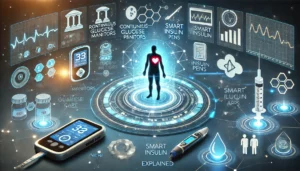alt=”Description of image content” style=”width:650px; height:auto;”/>
“`html
Revolutionizing Diabetes Care with IoT Open Source Glucose Monitoring
In the ongoing battle against diabetes, technology continues to offer new avenues for better management and monitoring. Among the latest developments is the integration of the Internet of Things (IoT) with open source systems, providing groundbreaking solutions for glucose monitoring. This advancement not only empowers patients but also paves the way for more personalized and effective diabetes care. Let’s explore how IoT open source glucose monitoring is ushering in a new era for diabetes management.
Understanding IoT and Its Role in Healthcare
The Internet of Things (IoT) refers to the interconnected network of devices exchanging data in real time. In healthcare, IoT has emerged as a transformative force, promising more efficient, data-driven health management. IoT in healthcare involves:
- Real-time data: Enabling continuous monitoring of patient vitals.
- Remote monitoring: Allowing health professionals to track patients’ health from afar.
- Automation: Streamlining tasks and reducing manual efforts in monitoring and data collection.
- Improved patient outcomes: Facilitating quicker responses to health issues.
In the context of diabetes, IoT is a powerful tool for real-time glucose monitoring, offering patients greater control over their condition.
The Power of Open Source in Diabetes Care
Open source software is characterized by its accessibility and collaborative enhancement by programmers worldwide. When applied to healthcare, particularly diabetes management, it provides significant advantages:
- Customization: Open source platforms allow for personalized software development to meet specific patient needs.
- Cost-efficiency: Reduces the expenses associated with proprietary software solutions.
- Community support: A community of developers continuously improves and updates the software.
- Transparency: Ensures that the code is visible and modifiable, fostering trust and innovation.
By merging IoT and open source paradigms, new glucose monitoring systems are becoming more accessible, adaptable, and effective.
How IoT Open Source Glucose Monitoring Works
IoT open source glucose monitoring systems leverage sensors, networks, and software to deliver real-time data and insights. Here’s how they typically operate:
1. Continuous Glucose Monitoring (CGM) Sensors
Advanced sensors are placed under the skin to continuously measure blood glucose levels. These sensors communicate wirelessly with IoT devices to track glucose data throughout the day and night without the need for constant finger pricks.
2. Data Transmission and Cloud Integration
The collected data is transmitted via Bluetooth or Wi-Fi to cloud storage, where it’s readily accessible to patients and healthcare providers. Key benefits include:
- Instant feedback: Patients can receive alerts and insights on their glucose levels instantly.
- Historical data tracking: Allows users to track their glucose patterns over time.
- Remote accessibility: Enables doctors to monitor patients remotely and intervene when necessary.
3. User-friendly Applications
Open source platforms provide flexibility in developing user-friendly applications that offer valuable insights and alerts:
- Customization: Patients can tailor their applications based on personal needs and preferences.
- Integration: Applications can integrate with smart devices such as phones, tablets, and smartwatches for seamless updates and alerts.
- Engagement: Patients are more likely to engage with their data when presented in an accessible manner.
Transforming Patient Experience and Health Outcomes
IoT open source glucose monitoring systems offer multiple benefits directly impacting patient experience and overall health outcomes:
Empowered Self-management
Patients equipped with these monitoring systems have the tools needed to manage their diabetes effectively. Real-time data enables patients to make informed decisions about their diets, exercise, and medication, leading to better glycemic control.
Reduced Healthcare Costs
With more accessible and effective monitoring, patients experience fewer complications, resulting in reduced hospital visits and medical expenses. Open source ecosystems help lower software costs significantly, making advanced diabetes care more affordable.
Improved Clinical Decision-Making
Healthcare providers can access up-to-date and comprehensive patient data, allowing for better informed clinical decisions. This leads to personalized treatment plans and more effective intervention strategies, enhancing patient outcomes.
Challenges and the Path Forward
Despite its immense potential, the adoption of IoT open source glucose monitoring is not without challenges:
- Data security: Ensuring the privacy and security of patient data in open source systems is critical.
- Technical barriers: Patients and healthcare providers may need training to use new technologies effectively.
- Interoperability: Ensuring systems work seamlessly across various devices and platforms.
Overcoming these challenges requires collaborative efforts from technology developers, healthcare professionals, and regulatory bodies. As technology evolves, fostering an environment that prioritizes security, ease of use, and innovation will be vital in fully realizing the benefits of IoT open source glucose monitoring.
Conclusion
The integration of IoT and open source technology in glucose monitoring is not just a technological advancement; it’s a revolution in diabetes care. By empowering patients with real-time insights and more control over their condition, IoT open source systems promise to redefine diabetes management. As we move forward, continuous improvements and concerted efforts to address challenges will help make these technologies an integral part of the standard diabetes care regimen.
“`



